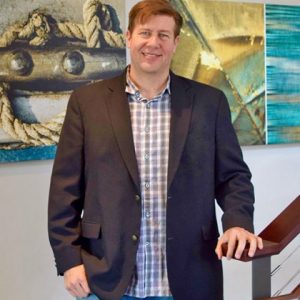ArcherPoint CEO, Greg Kaupp, isn’t one to wait around for things to happen.
After leading an impressive growth run at the Microsoft NAV reseller and implementer – jumping from roughly $12.6 million in 2012 to just under $20 million in 2015 – Kaupp’s leading a change in structure at his organizations in hopes of sparking the next wave of growth.
I recently sat down with Kaupp to learn more about this significant change.
Theriault: Growth has been strong the past few years, yet you are making a significant change to how you operate internally. What is driving the change?
Kaupp: When we grew to the 30-50 employee range, we began to realize what had been working for us before wasn’t working as well as it used to. We had outgrown the people systems that were in place. As a result, we struggled for a couple of years to put the right people systems in place until we discovered EOS or Traction. Traction served us well and helped us grow from 60 people in almost three years to just under 100 today.
Now, we are encountering a new set of barriers to growth and our current structure is not as dynamic or responsive as we need it to be. We realized that to continue to scale, we would need to add more overhead even though we were already seeing miscommunication occurring between departments. At our present size, the traditional hierarchical structure was beginning to feel too unwieldly.
Theriault: You decided to shift your organization’s structure to Holocracy – a more distributed-authority model of an organization. Where do you think this structure will allow you to go?
Kaupp: We recently formed the ArcherPoint ESOP. Our desire is to unlock the entrepreneurial energy of an entire organization of employee owners. As we look at the business, we look at five levers – revenue, profit, employees, clients and valuation. The challenge is, how do we double any three of these levers in three years? This forces us to think, “How do we do something that, today, seems nearly impossible?” If that is our starting point, we know we will only get there by thinking, organizing and acting differently.
Theriault: What do you think will be possible to do that you can’t do today?
Kaupp: Holocracy creates a space for everyone to have a voice. Already, we are seeing co-workers – who in the past, you didn’t hear much from because there wasn’t a space where they could speak up from – participate at levels that are absolutely surprising.
Theriault: Did you see value right out of the gate with this shift in structure? Kaupp: We did. Before even learning about the Holocracy structure, I saw that we were throwing more and more bodies at gaining more revenue, but profits remained flat. We were seemingly stuck.
We started two Holacracy pilots and very quickly saw how this new structure could empower people and energize people. As leaders, the structure allows us to give people the ability to make decisions within their roles and eliminate the need for them to seek permission for everything they do. It gives people both the authority and the autonomy to energize and fulfill the purpose and accountabilities of their roles. The more we have seen Holocracy in action, the more sense it makes. I believe that we all learn by doing and the only way that we can create the organization of the future, is by energizing and evolving the organization through exploration and adaptation. The old paradigm of command and control or predict and control just doesn’t lend itself to an agile, adaptive organization. I’m constantly trying to push back and say to our team, “You are able to do this.”
When you have an issue in your organization, all the research says, “80 percent of the time, it is a process or organizational issue, not a people issue.” Yet, what do we immediately go to all the time? “We need better people, or different people.” Well, what we are seeing is, by addressing this as an organizational and a process issue, leaders emerge that would not have been identified earlier – or maybe ever. We are finding that roles, which traditionally aren’t leadership roles, are creating leaders.
Theriault: What has been the biggest challenge to rolling out the Holocracy structure?
Kaupp: The fear of change. However, I don’t think people really fear change. What people really fear is loss. Often, we are afraid that change will represent some sort of loss, typically a loss of control or a loss of competence.
Theriault: How are you directly dealing with that fear?
Kaupp: Through a lot of communication and access. We do a bi-weekly call where we talk about the Holocracy book, which everyone is reading in our organization. This process is opening up opportunities for questions to be asked. It may start with a question about the book, but then it moves into a discussion around how this might affect us or what this will look like in our organization.
It also opens up the opportunity for those who have been in Holocracy pilot groups to share live examples of their experience to date. Every time we have one of these sessions, it diminishes the fear and our people are getting more and more comfortable with the idea.
Theriault: As CEO, how are you having to adapt and change?
Kaupp: I have to let go of the vine. In our former structure, all roads led back to me. The bigger the organization has grown, the more it is clear to me that I am not the best person to make decisions for every area of the organization.
The people closest to the point of impact need to be the ones making the decisions. I love the business we are in and I wanted to figure out how I can be an individual contributor in roles in the organization where I really feel like I have something to offer. The challenge in a traditional structure is that it is kind of a violation of the process – for the executive to play a role somewhere down in the organization.
Theriault: How will your role directly change?
Kaupp: I will remain what is called the, “lead link,” of the general company circle, which is the overarching structure that everything exists within. Once the organization is operating efficiently on Holocracy, that role should only consume about 10 percent of my time. When that occurs, I’m free to apply the remaining 90 percent of my time to other areas that I’m passionate about as an individual contributor, be it sales, marketing or something in operations. This new structure will allow me to fulfill a role on a team and have input just like anyone else.
Theriault: Clearly, this isn’t a structure made for every CEO. What traits do you think will allow you to see this through successfully?
Kaupp: I’m all gas pedal – no brake – but blessed with a lot of patience. Because I have a lot of patience, I can moderate the gas pedal and allow us to see this through even though it will likely take us years before we feel like we’ve perfected this system. For someone who is impatient, or can’t give up control, this change would be very difficult.
I also have had to grow in humility. I have had to accept there are other people who can make better decisions than I ever could based on how close they are to an issue or situation. I believe distributed authority and decision making will ultimately make us a much more agile organization.







